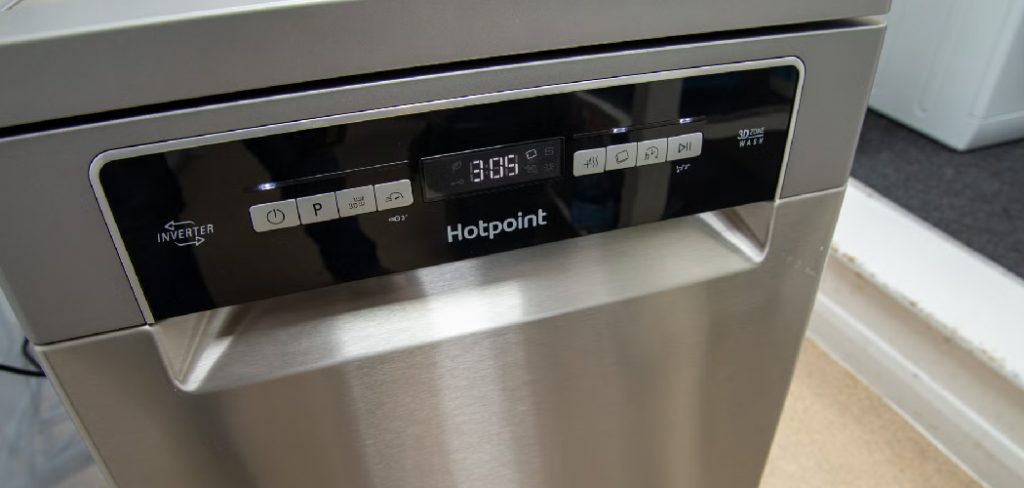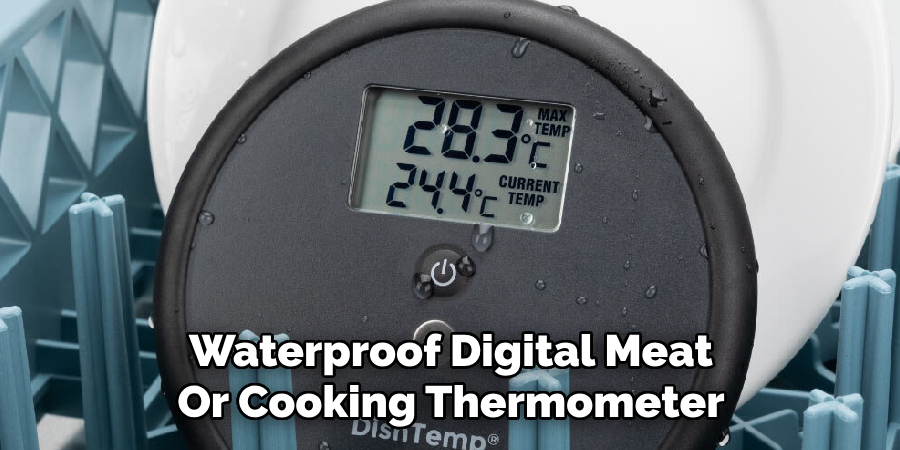Maintaining the correct water temperature in your dishwasher is essential for optimal cleaning and sanitizing performance. Dishwashers rely on hot water to break down grease, remove residue, and kill germs effectively.
If the water temperature is too low, it can result in poorly cleaned dishes and unmet hygiene standards. On the other hand, excessively high temperatures may damage your dishes or components of your appliance.

Water at the right temperature also ensures that detergents dissolve and activate correctly, delivering spotless and sanitized results every time. Understanding how to check dishwasher temperature helps you monitor this crucial factor, ensuring your dishwasher operates efficiently.
This article aims to provide a comprehensive guide to checking your dishwasher’s water temperature. By following the steps outlined here, you can troubleshoot potential issues, maintain energy efficiency, and extend the longevity of your appliance while ensuring the cleanliness and safety of your dishes.
Why Dishwasher Temperature Matters
Maintaining the correct water temperature in your dishwasher is essential for achieving optimal cleaning performance and ensuring the safety of your dishes. The recommended temperature range for most dishwashers is between 120-160°F (49-71°C). Water in this range strikes the right balance between effectively removing grease and grime while ensuring detergents dissolve properly for thorough cleaning.
Ideal Dishwasher Temperature
Water temperatures between 120-160°F provide the best results when breaking down food residues and sanitizing. Detergent components are fully activated at these temperatures, delivering sparkling, spot-free dishes. Lower temperatures cannot dissolve grease or activate detergent effectively, often leaving food particles and residue behind.
How Temperature Affects Cleaning
Heat plays a crucial role in dishwasher performance. Hot water dissolves detergents more efficiently, allowing them to break down tough food residues. Additionally, high temperatures sanitize dishes by killing harmful bacteria and germs, ensuring a hygienic clean after every cycle.
Consequences of Incorrect Temperature
Incorrect water temperature can lead to several issues. If the water is too low, your dishes may remain dirty, and harmful bacteria may not be eliminated.

Conversely, excessively high temperatures can damage delicate dishes like glassware or plastic and unnecessarily increase energy consumption. By maintaining the right temperature, you ensure optimal performance and extend the life of both your dishes and your dishwasher.
Tools You’ll Need to Check Dishwasher Temperature
Accurately checking your dishwasher’s temperature requires a few essential tools to ensure reliable readings and safe handling. Here’s what you’ll need:
Thermometers
The most critical tool for the task is a thermometer. Digital, probe-style thermometers are highly recommended because they offer precise temperature readings and are easy to use. These thermometers are designed to handle high heat and can be immersed in water safely. You can purchase them conveniently online or at local hardware stores, with many affordable options available to suit different budgets.
Other Tools
Towels are another necessary item, not just to handle potential spills but also to protect your hands when dealing with hot water. Their use ensures safe handling while checking the temperature.
For tech-savvy users, a smartphone app equipped with temperature-tracking features can be helpful, especially if you’re using compatible smart home devices for such functions. Although optional, this modern solution can provide additional convenience and insights into maintaining your dishwasher’s efficiency.
With these tools, you’ll be well-prepared to effectively measure and monitor your dishwasher’s water temperature, ensuring optimal performance and hygienic cleaning cycles.
Checking the Temperature with a Thermometer

Step-by-Step Instructions
To ensure your dishwasher’s water temperature is appropriate for optimal cleaning and sanitization, you can check it using a thermometer. Here’s how to perform the test:
- Setting up the dishwasher
Begin by loading the dishwasher as you normally would, ensuring dishes are present to mimic real-use conditions. Select a standard or normal cycle to test the water temperature accurately.
- Preparing the thermometer
Use a thermometer that is capable of reading high temperatures, such as a waterproof digital meat or cooking thermometer. Place the thermometer securely in a heat-resistant glass or cup.
- Positioning the thermometer
Set the glass or cup containing the thermometer on the dishwasher’s bottom rack. Ensure it is stable and will not tip over during the cycle to avoid damage or inaccurate readings.
- Running the cycle
Close the dishwasher door and allow the cycle to run. Focus on letting the dishwasher progress to the final rinse phase, as this is typically when the water reaches its peak temperature.
- Checking the thermometer reading
Once the cycle is complete, carefully open the dishwasher door and retrieve the thermometer. Record the temperature displayed to determine if it meets the recommended range, generally between 120°F and 150°F.
Best Time to Test
The ideal time to check the water temperature is during the final rinse or wash cycle. This stage typically delivers the hottest water, providing the most accurate representation of your dishwasher’s performance. Regular testing can help ensure consistent cleaning results and maintain the efficiency of your appliance.
How to Check Dishwasher Temperature: Using a Digital or Smart Thermometer
How Digital Thermometers Work
Digital probe thermometers offer an exact way to measure dishwasher water temperature. To use a digital thermometer, place the probe tip inside a heat-safe container filled with water and position it on the dishwasher’s bottom rack. Start the cycle and monitor the temperature displayed on the thermometer’s screen.
These thermometers are designed to provide accurate, real-time readings, allowing you to pinpoint the peak water temperature during the rinse or wash phase without guesswork. Portable and easy to operate, digital thermometers are an excellent tool for those seeking precision.
Using Smart Technology
Modern advancements have introduced dishwashers equipped with built-in temperature sensors and smart technology. These sensors continuously monitor the water temperature during each cycle to optimize cleaning performance and energy efficiency.
Many of these appliances can be paired with a smartphone app, providing real-time data and alerts directly to your device. This integration is convenient for tracking temperature trends across multiple cycles, ensuring your dishwasher maintains effective cleaning standards over time.
When to Rely on Digital Tools
Digital or smart thermometers are ideal for individuals who require detailed or continuous temperature monitoring. For instance, those managing commercial kitchens or ensuring sanitized dishwasher performance in healthcare settings can benefit from the accuracy and convenience offered by these tools.

Additionally, homeowners who regularly test and tune their household appliances may find digital thermometers indispensable for maintaining optimal dishwasher performance and water safety.
Interpreting the Results
Ideal Temperature Range
For optimal dishwasher performance, the water temperature should typically range between 120°F and 150°F (49°C to 66°C). This range ensures effective cleaning and disinfection while protecting your dishes and appliance components from potential damage. If your readings fall within this range, your dishwasher functions correctly, and no immediate action is required. You can continue to monitor periodically to maintain efficiency.
Too Cold or Too Hot
If the water temperature falls below 120°F (49°C), it may be too cold to dissolve detergent effectively or sanitize dishes. This could indicate a malfunctioning heating element or issues with the hot water supply. To address this, check your water heater settings or consider scheduling a professional inspection of the dishwasher’s heating element.
Conversely, if the temperature exceeds 150°F (66°C), the water may be too hot, which can damage delicate dishes or the appliance’s internal components. A miscalibrated or faulty thermostat could cause high temperatures. Adjust the thermostat as needed or consult a technician to replace defective parts.
Consulting the Manual
Always refer to your dishwasher’s user manual for specific water temperature and maintenance recommendations. Manufacturers provide tailored guidelines for their models, helping you diagnose issues accurately and take appropriate actions to preserve your appliance’s performance.
Troubleshooting Common Temperature Issues
Water Isn’t Hot Enough
If your dishwasher’s water isn’t reaching the correct temperature, it could stem from several potential causes. A faulty heating element, a malfunctioning thermostat, or incorrectly configured water heater settings are common culprits. First, verify that your water heater is set to at least 120°F (49°C).
If the issue persists, inspect the dishwasher’s heating element for damage or use a multimeter to test its functionality. Replacing a defective element or thermostat might be required. If you’re unsure, consult a technician for a professional evaluation.
Water Is Too Hot
Excessively hot water may result from a malfunctioning thermostat or an issue with the water inlet valve, allowing unregulated hot water to flow in. Begin by checking the thermostat settings and recalibrating them if necessary. If the problem persists, inspect the water inlet valve for defects or blockage.
Replacing faulty components or consulting a professional technician can help resolve the issue effectively while safeguarding your dishwasher and dishes.
Maintaining the Right Temperature
Maintaining the correct water temperature in your dishwasher is essential for optimal cleaning performance and energy efficiency. Regular checks of the water heater and dishwasher temperature settings are crucial to ensure consistent results. Experts recommend testing the temperature at least once a month by running the dishwasher and using a thermometer to measure the water’s heat.
Balancing temperature settings is also key to energy efficiency. While a temperature of around 120°F (49°C) to 140°F (60°C) is ideal for cleaning and sanitization, lowering it closer to the minimum range can help reduce energy consumption without compromising results. This allows your dishwasher to maintain peak performance while conserving energy.
Preventative maintenance, such as cleaning the heating elements, filters, and water inlet valve regularly, helps ensure the dishwasher heats water efficiently and functions smoothly. By adopting these practices, you can extend the lifespan of your appliance and enjoy consistently clean dishes.

Conclusion
Checking the dishwasher temperature is essential for effectively cleaning and maintaining energy efficiency. Regularly monitoring and ensuring the water temperature stays within the recommended range of 120°F to 140°F can prevent potential issues and guarantee spotless dishes after every cycle.
By understanding how to check dishwasher temperature, you can quickly identify and address any inconsistencies, ensuring your appliance continues functioning at its best. If the temperature falls outside the ideal range despite adjustments, it’s recommended to troubleshoot common issues or contact a professional for assistance. These steps will help maintain your dishwasher’s performance and peace of mind.
Professional Focus
Angela Ervin, a former interior designer turned blogger, specializes in kitchen design and renovations. Through her website, she blends her passion for cooking with design expertise, sharing practical and creative ideas. Known for balancing functionality and beauty, Angela’s insightful content has made her a trusted voice in home design and lifestyle.
About the Author
Angela Ervin, an experienced interior designer and blogger, combines her passion for kitchen renovations with storytelling. Living in Petersburg with her family, she enjoys cooking and testing her projects firsthand. Known for her humor and relatable style, Angela shares creative, functional design insights through her content, making her a trusted voice in home design.
Education History
University: Virginia Commonwealth University
Degree: Bachelor of Fine Arts (BFA) in Interior Design
- Angela’s education at VCU focused on mastering core interior design principles, including spatial planning, color theory, materials selection, and sustainable design practices.
- She gained hands-on experience through studio projects and collaborative design exercises, which honed her ability to create functional and aesthetically pleasing environments.
- Her coursework also emphasized problem-solving and practical applications of design, preparing her for real-world projects like her self-directed kitchen renovations.
- The program’s strong foundation in both technical skills and creative expression shaped Angela’s ability to seamlessly integrate form and function in her work.
